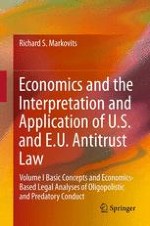2014 | OriginalPaper | Buchkapitel
Chapter 11 Predatory Conduct
verfasst von : Richard S. Markovits
Erschienen in: Economics and the Interpretation and Application of U.S. and E.U. Antitrust Law
Verlag: Springer Berlin Heidelberg
Aktivieren Sie unsere intelligente Suche, um passende Fachinhalte oder Patente zu finden.
Wählen Sie Textabschnitte aus um mit Künstlicher Intelligenz passenden Patente zu finden. powered by
Markieren Sie Textabschnitte, um KI-gestützt weitere passende Inhalte zu finden. powered by
